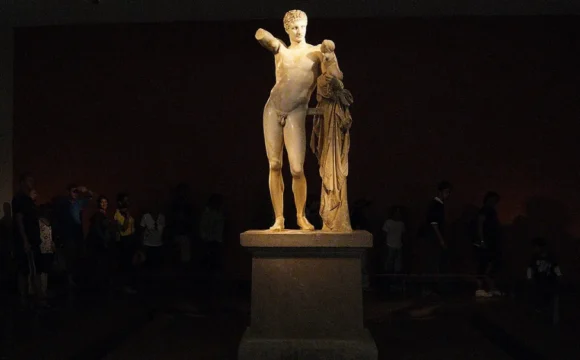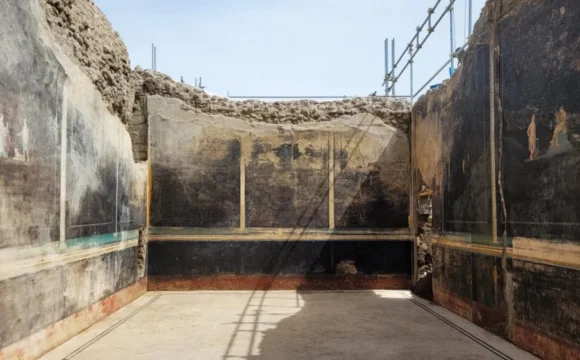นักโบราณคดีชาวอังกฤษค้นพบสิ่งที่ฟังดูเหมือนเรื่องราวจากภาพยนตร์ Indiana Jones เมื่อเร็ว ๆ นี้ ที่สุสานลับใต้เมืองโบราณ Petra ย่านมรดกโลกของจอร์แดน ตามที่ระบุในข่าวประชาสัมพันธ์จากมหาวิทยาลัยเซนต์แอนดรูว์ส
นักโบราณคดี นำโดย Richard Bates ศาสตราจารย์จาก St. Andrews และ Pearce Paul Creasman ผู้อำนวยการบริหารของ American Center of Research กำลังสำรวจอาคาร Treasury ที่โดดเด่นของ Petra ซึ่งปรากฏในภาพยนตร์เรื่อง Indiana Jones and the Last Crusade ในปี 1989 (ในภาพยนตร์ อาคารแห่งนี้เป็นที่ตั้งของจอกศักดิ์สิทธิ์ แม้ว่าวัตถุประสงค์ที่แท้จริงยังคงเป็นปริศนาส่วนใหญ่)
เป็นเวลาหลายทศวรรษที่นักโบราณคดีทราบว่ามีสุสานอยู่รอบ ๆ บริเวณนี้ แต่ไม่สามารถสำรวจได้อย่างเต็มที่ จากนั้นในปีนี้ Bates, Creasman และทีมได้รับอนุญาตจากรัฐบาลจอร์แดนให้ใช้เรดาร์เจาะพื้นดินบนไซต์ เมื่อการสำรวจพบความเป็นไปได้สูงของห้องใต้ดินในคลังสมบัติ พวกเขาได้รับอนุญาตให้ขุดค้น ทีมค้นพบเชื่อว่าสุสานที่ถูกฝังอยู่นี้ไม่ได้รับการกระทบกระเทือนมานานกว่าสองพันปี ภายในประกอบด้วยซากโครงกระดูก 12 ชิ้นและของเซ่นไหว้
“การค้นพบนี้มีความสำคัญระดับนานาชาติ เนื่องจากการกู้การฝังศพที่สมบูรณ์แบบจากชาวนาบาเทียนยุคแรก ๆ จาก Petra นั้นมีเพียงไม่กี่ครั้ง” ศาสตราจารย์ Richard Bates จาก University of St. Andrews School of Earth and Environmental Science กล่าวในแถลงการณ์สื่อ “การฝังศพ สินค้า และซากมนุษย์ทั้งหมดคาดว่าจะช่วยเติมเต็มช่องว่างของความรู้ของเราเกี่ยวกับที่มาของ Petra ย่านมรดกโลกและชาวนาบาเทียนเป็นใคร" เขากล่าวเสริม
หนึ่งในโครงกระดูกถือถ้วยที่คล้ายกับจอกศักดิ์สิทธิ์ในภาพยนตร์ Josh Gates เจ้าภาพของ “Expedition Unknown" ของ Discovery Channel ซึ่งถ่ายทำรายการโทรทัศน์ที่จะออกอากาศเกี่ยวกับการขุดสุสาน กล่าวในแถลงการณ์สื่อ “มันเป็นช่วงเวลาสุดท้ายของชีวิตที่เลียนแบบศิลปะ"
“เมื่อเราเห็นสิ่งที่ดูเหมือนจอก เราทุกคนก็หยุดนิ่ง มันดูเหมือนจอกศักดิ์สิทธิ์ใน Indiana Jones and the Last Crusade ซึ่งตั้งอยู่ในอาคารโบราณที่อยู่เหนือสุสานโดยตรง" เขากล่าว
การวิเคราะห์รายละเอียดของภาชนะเซรามิกพบว่าเป็นส่วนบนของเหยือกที่แตกซึ่งเชื่อว่ามีอายุย้อนไปถึงศตวรรษที่ 1 ก่อนคริสต์ศักราช
“สุสานนั้นน่าจะสร้างขึ้นเพื่อเป็นสุสานและสุสานในอาณาจักรนาบาเทียนในช่วงต้นศตวรรษที่ 1 AD สำหรับ Aretas IV Philopatris" Bates กล่าว “เช่นเดียวกับสุสานหลายแห่งในหุบเขา ไม่เคยพบซากศพในสุสานเนื่องจากการใช้และการใช้ซ้ำในสองพันปีที่ผ่านมา"
จากบทความโดย George Nelson for ArtNews
British archaeologists recently made a discovery that sounds like something straight out of an Indiana Jones movie: a secret tomb under the ancient city of Petra in Jordan, according to a press release from the University of St. Andrews.
The archaeologists, led by Richard Bates, a professor at St. Andrews, and Pearce Paul Creasman, the executive director of American Center of Research, were exploring Petra’s iconic Treasury building, which was featured in 1989 blockbuster Indiana Jones and the Last Crusade. (In the film, the building is home to the Holy Grail, though its actual purpose has remained mostly a mystery.)
For decades, archaeologists have known that there were tombs around the structure, but had been unable to fully explore them. Then, this year Bates, Creasman, and the team were approved by the Jordanian government to use ground-penetrating radar on the site. When the survey found the strong possibility of subterranean chambers in the Treasury, they were given permission to excavate. The team found a buried tomb, believed to have been undisturbed for two millennia, containing the remains of 12 skeletons and a collection of grave offerings.
“The discovery is of international significance as very few complete burials from the early Nabataeans have ever been recovered from Petra before," professor Richard Bates from the University of St. Andrews School of Earth and Environmental Science said in a press statement. “The burials, their goods, and the human remains can all be expected to help fill the gaps of our knowledge in how Petra came to be and who the Nabataeans were," he added.
One of the skeletons was even holding a chalice that resembled the cinematic Holy Grail. Josh Gates, the host of Discovery Channel’s “Expedition Unknown," which filmed a soon-to-air TV program on the tomb excavation, said in a press statement, “It was the ultimate moment of life imitating art."
“When we spotted what looked like a chalice, all of us just froze. It looked nearly identical to the Holy Grail featured in Indiana Jones and the Last Crusade, set in the ancient building directly above the tomb," he said.
Detailed analysis of the ceramic vessel revealed that it is the top part of a smashed jug that is thought to date back to the first century BC.
“The tomb was most likely built as a mausoleum and crypt in the Nabatean Kingdom at the beginning of the 1st century AD for Aretas IV Philopatris," Bates said. “Like many tombs in the valley, few remains have ever been found in the tombs due to their subsequent use and reuse over the last two millennia."
From the article by George Nelson for ArtNews








